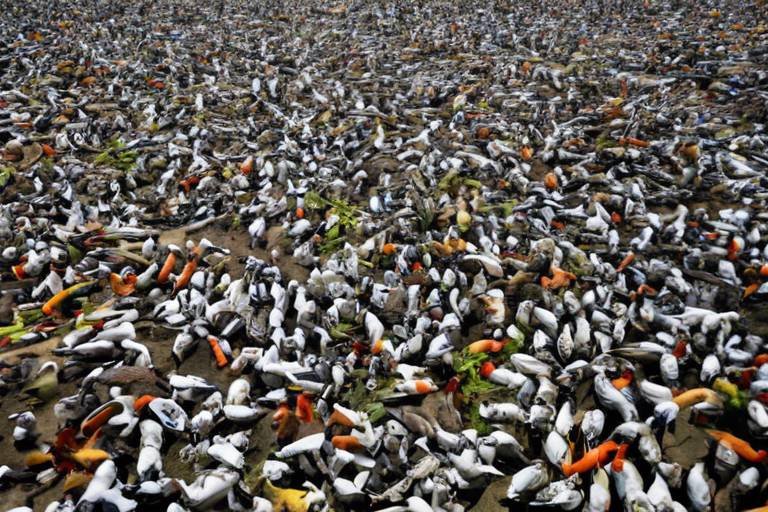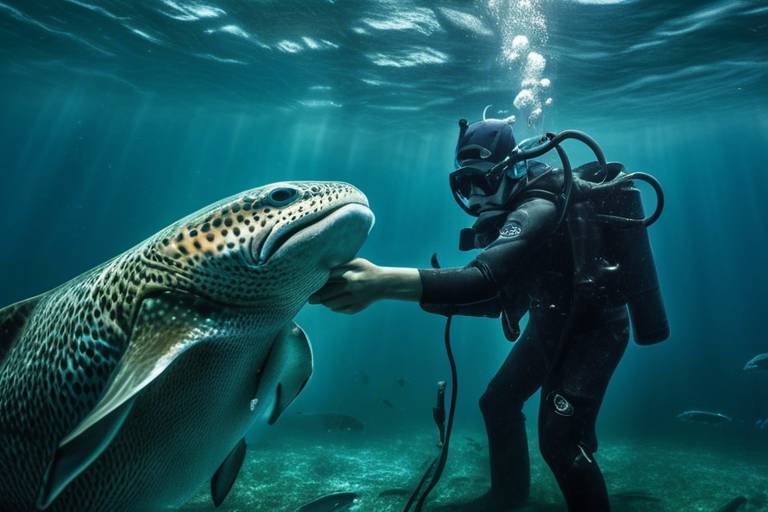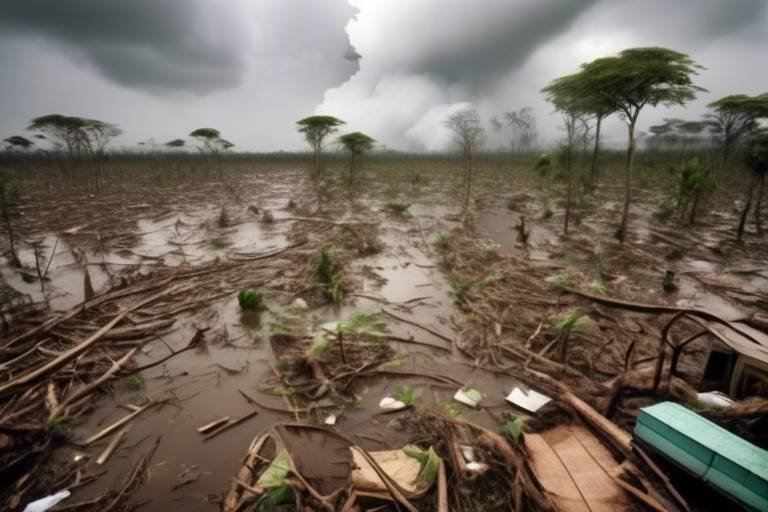Grassroots Conservation: Why Community Involvement Matters
In an age where environmental issues seem to dominate headlines, the importance of community engagement in conservation efforts cannot be overstated. Grassroots conservation is about more than just protecting nature; it's about empowering local people to take charge of their own ecosystems. Imagine a community that feels a deep connection to its natural surroundings, where every individual understands their role in preserving the environment. This is the essence of grassroots conservation, where the strength of community involvement leads to sustainable practices and a healthier planet.
When communities come together to tackle environmental challenges, they harness a wealth of traditional knowledge and cultural practices that have been passed down through generations. This local wisdom is invaluable, as it provides insights into the intricacies of local ecosystems and biodiversity. By integrating this knowledge with modern conservation techniques, communities can create more effective strategies that not only protect the environment but also enhance their livelihoods.
Moreover, the impact of community involvement extends far beyond the immediate environmental benefits. It fosters a sense of ownership and responsibility among community members, encouraging them to become active stewards of their natural resources. When people feel that they have a stake in the health of their environment, they are more likely to engage in conservation efforts and advocate for sustainable practices. This empowerment can lead to a ripple effect, inspiring others in the community to join in and contribute to a collective goal of environmental sustainability.
In essence, grassroots conservation is a powerful reminder that when we work together, we can achieve remarkable outcomes. As we delve deeper into the various aspects of community involvement in conservation, we will uncover the numerous benefits it brings, the challenges faced, and the innovative solutions that communities are implementing to overcome these obstacles. Through this exploration, we will see how the fusion of local knowledge, education, and collaboration can pave the way for a brighter, more sustainable future.
Local communities play a crucial role in conservation initiatives, often serving as the first line of defense in protecting biodiversity and natural habitats through traditional knowledge and stewardship practices.
Community-led conservation approaches yield numerous benefits, including enhanced ecological resilience, improved livelihoods, and strengthened social cohesion, demonstrating how local involvement can lead to more effective and sustainable environmental outcomes.
Education initiatives within communities empower individuals with the knowledge and skills necessary for effective conservation, fostering a sense of ownership and responsibility for local natural resources and ecosystems.
Workshops and training programs equip community members with practical tools and strategies to engage in conservation efforts, promoting sustainable practices that benefit both the environment and local economies.
Awareness campaigns raise consciousness about the importance of conservation, encouraging community members to participate actively in protecting their natural surroundings and advocating for sustainable practices.
Collaborative conservation projects unite various stakeholders, including local communities, NGOs, and government agencies, to create comprehensive strategies that address environmental challenges while respecting local needs and knowledge.
Despite its benefits, grassroots conservation faces challenges such as funding limitations, political barriers, and external pressures, which can hinder community efforts and compromise environmental sustainability.
Securing adequate funding and resources is a significant challenge for grassroots conservation initiatives, often requiring innovative approaches to mobilize support and ensure long-term sustainability of projects.
Political and legal obstacles can impede grassroots conservation efforts, necessitating advocacy and policy changes that empower local communities to effectively manage and protect their natural resources.
- What is grassroots conservation? Grassroots conservation refers to community-led initiatives aimed at protecting and managing local natural resources and ecosystems.
- Why is community involvement important in conservation? Community involvement ensures that local knowledge and needs are integrated into conservation strategies, leading to more effective and sustainable outcomes.
- What are some challenges faced by grassroots conservation efforts? Challenges include funding limitations, political barriers, and external pressures that can hinder community initiatives.
- How can communities be empowered for conservation? Through education, training programs, and awareness campaigns, communities can gain the knowledge and skills necessary for effective conservation.

The Role of Local Communities in Conservation
Local communities are often the unsung heroes in the world of conservation. They are the ones who live and breathe the environment, understanding its rhythms and nuances like no one else. Imagine a village nestled in a lush valley, where the residents have spent generations learning the best practices for farming, fishing, and foraging. They possess a wealth of traditional knowledge that is vital for protecting biodiversity and natural habitats. This intimate connection to the land allows them to act as the first line of defense against environmental degradation.
When we talk about conservation, it's essential to recognize that local communities are not just passive recipients of external aid; they are active participants in the process. Their stewardship practices, honed over centuries, often include sustainable land management, wildlife protection, and the preservation of local ecosystems. For instance, many indigenous communities have developed intricate systems of resource management that have proven effective in maintaining ecological balance. These practices are not merely cultural artifacts; they are practical solutions that can be scaled and adapted to modern conservation challenges.
Furthermore, community involvement in conservation fosters a sense of ownership and responsibility. When locals are engaged, they are more likely to advocate for their environment, ensuring that conservation efforts are not only effective but also sustainable over the long term. This engagement can take various forms, from participating in local conservation initiatives to advocating for policies that protect their natural resources. The empowerment of communities is crucial; when people feel connected to their environment, they are motivated to protect it.
To illustrate the significance of local communities in conservation, consider the following table that highlights key roles they play:
| Role | Description |
|---|---|
| Stewardship | Communities manage local resources sustainably, ensuring biodiversity and ecosystem health. |
| Knowledge Sharing | Traditional ecological knowledge is passed down, providing insights into sustainable practices. |
| Advocacy | Local voices advocate for policies that protect their environment and resources. |
| Monitoring | Communities can monitor environmental changes and report issues effectively. |
In summary, the role of local communities in conservation is multifaceted and vital. Their deep-rooted knowledge, coupled with a strong sense of responsibility, makes them indispensable allies in the fight for environmental sustainability. By empowering these communities and integrating their insights into broader conservation strategies, we can create a more effective and inclusive approach to protecting our planet.
- Why are local communities important for conservation? Local communities possess traditional knowledge, skills, and a sense of responsibility that are crucial for effective conservation efforts.
- How can communities contribute to conservation? They can engage in stewardship practices, advocate for policies, and share their traditional ecological knowledge.
- What challenges do local communities face in conservation? Challenges include funding limitations, political barriers, and external pressures that can undermine their efforts.

Benefits of Community-Led Conservation
When we think about conservation, it's easy to imagine scientists in lab coats or government officials drafting policies. However, the real magic often happens at the grassroots level, where community-led conservation initiatives take center stage. These approaches not only empower local populations but also foster a deep connection between people and their environment. So, what are the tangible benefits of involving communities in conservation? Let's dive in!
First and foremost, community-led conservation enhances ecological resilience. Local communities often possess invaluable traditional knowledge about their ecosystems, passed down through generations. This knowledge helps them identify the most effective methods for managing resources sustainably. For instance, indigenous practices such as rotational farming or seasonal fishing align perfectly with modern conservation techniques, creating a harmonious balance between nature and human activity. By leveraging this wisdom, communities can adapt to environmental changes more effectively, ensuring that local ecosystems remain robust and vibrant.
Moreover, these initiatives significantly improve livelihoods. When communities are actively involved in conservation, they are more likely to see direct benefits from their efforts. Sustainable practices can lead to better agricultural yields, enhanced fish stocks, and even eco-tourism opportunities. Imagine a village that transforms its natural beauty into a thriving eco-tourism destination, providing jobs and income for its residents while simultaneously protecting the environment. This is not just a dream; it's happening in communities around the world, showcasing how conservation can be a pathway to economic empowerment.
Another compelling advantage is the strengthening of social cohesion. When people come together for a common cause, they build stronger bonds. Community-led conservation projects often require collaboration, which fosters teamwork and trust among members. This social fabric can lead to a more resilient community, capable of facing various challenges—whether they are environmental, economic, or social. In essence, conservation becomes a catalyst for unity, encouraging individuals to work together for a brighter future.
To illustrate these benefits further, let's take a look at a few key points in the table below:
| Benefit | Description |
|---|---|
| Ecological Resilience | Utilizing traditional knowledge to manage ecosystems sustainably. |
| Improved Livelihoods | Creating economic opportunities through sustainable practices. |
| Social Cohesion | Building trust and collaboration among community members. |
In conclusion, the benefits of community-led conservation extend far beyond environmental protection. They touch on the very essence of community life, enhancing resilience, boosting livelihoods, and fostering unity. By empowering local populations to take charge of their natural resources, we not only protect our planet but also create thriving communities that are capable of facing the future with confidence.
- What is community-led conservation? Community-led conservation refers to initiatives where local communities take the lead in managing and protecting their natural resources.
- Why is community involvement important in conservation? Community involvement is crucial because local people possess unique knowledge and a vested interest in the health of their ecosystems, leading to more effective and sustainable outcomes.
- How can communities benefit economically from conservation? Communities can benefit economically through sustainable practices that enhance resource availability, create jobs in eco-tourism, and improve agricultural productivity.

Empowerment Through Education
Education is a powerful tool that can transform communities and foster a deep sense of responsibility towards the environment. When local individuals are equipped with knowledge about their ecosystems, they become more than just passive observers; they evolve into active participants in conservation efforts. This empowerment through education is essential for instilling a sense of ownership over local natural resources. Imagine a community that understands the intricate balance of its local ecosystem; they are more likely to protect it fiercely, knowing the direct impact their actions have on their environment.
One of the most effective ways to achieve this empowerment is through targeted educational initiatives that focus on both conservation techniques and the importance of biodiversity. These programs often include workshops, training sessions, and community meetings that encourage dialogue and collaboration. For instance, a workshop on sustainable farming practices not only teaches farmers how to reduce their environmental footprint but also helps them understand how healthy ecosystems can lead to better crop yields. This dual benefit creates a win-win situation where both the community and the environment thrive.
Furthermore, awareness campaigns play a significant role in complementing educational efforts. They help raise consciousness about the importance of conservation and encourage community members to actively participate in protecting their natural surroundings. For example, a local campaign might highlight the significance of wetlands in maintaining water quality and biodiversity. By showcasing the direct benefits of preserving these ecosystems, community members are motivated to engage in conservation activities, such as clean-up drives or tree planting events.
In addition to workshops and awareness campaigns, educational programs often include hands-on activities that make learning engaging and impactful. These might involve field trips to local conservation sites, where community members can observe and participate in ongoing conservation efforts. Such experiences not only enhance learning but also build a sense of community and shared purpose. When individuals see the tangible results of their efforts—like the return of native species or the restoration of a degraded area—they are more likely to continue their involvement and inspire others to join in.
To illustrate the impact of education on community empowerment, consider the following table that summarizes key educational initiatives and their outcomes:
| Educational Initiative | Outcome |
|---|---|
| Sustainable Farming Workshops | Increased crop yields and reduced chemical use |
| Wetland Awareness Campaign | Higher community participation in wetland conservation |
| Field Trips to Conservation Sites | Enhanced understanding of local ecosystems and biodiversity |
In conclusion, education serves as the backbone of grassroots conservation efforts. By empowering individuals with knowledge and skills, communities can take charge of their environmental stewardship. As they become more informed and engaged, they not only contribute to the sustainability of their ecosystems but also foster a culture of conservation that can be passed down through generations.

Workshops and Training Programs
Workshops and training programs are essential components of grassroots conservation efforts, acting as the backbone for community engagement and empowerment. These initiatives provide community members with the practical skills and knowledge necessary to participate actively in conservation activities. Imagine a small village where the local population learns how to sustainably manage their fishing practices. Instead of depleting fish stocks, they discover methods to ensure that their livelihoods remain intact while preserving the aquatic ecosystem. This is precisely the kind of transformation that workshops can foster.
Through hands-on training sessions, participants can engage directly with conservation experts who share valuable insights into local ecosystems, biodiversity, and sustainable practices. For instance, a workshop might cover topics such as:
- Native plant restoration
- Water conservation techniques
- Wildlife monitoring and protection
- Community-based tourism initiatives
These programs not only enhance the participants' understanding of their environment but also cultivate a sense of ownership over local resources. When community members feel equipped with the right tools and knowledge, they are more likely to take an active role in conservation efforts. Moreover, the collaborative nature of these workshops fosters social bonds among participants, strengthening community ties and encouraging collective action.
Furthermore, workshops can serve as platforms for sharing success stories and best practices. By highlighting successful conservation initiatives from other communities, participants can draw inspiration and adapt these strategies to their unique circumstances. This exchange of ideas creates a ripple effect, as communities learn from one another, sparking innovation and resilience in conservation efforts.
In addition to practical skills, workshops often include components on advocacy and policy engagement. Community members learn how to navigate local governance structures and advocate for policies that support conservation initiatives. This knowledge empowers them to not only protect their environment but also to influence decision-making processes that affect their livelihoods.
Ultimately, workshops and training programs are not just about imparting knowledge; they are about igniting a passion for conservation. When individuals leave these sessions, they carry with them a newfound commitment to protecting their natural surroundings. As they put their learning into action, they become champions of conservation, inspiring others in their community to join the cause.
Q: What types of workshops are available for community members interested in conservation?
A: Workshops can cover a wide range of topics including sustainable agriculture, wildlife protection, and ecosystem restoration. They often include hands-on activities and expert-led discussions.
Q: How can communities organize their own workshops?
A: Communities can collaborate with local NGOs, universities, or conservation organizations to plan and facilitate workshops tailored to their specific needs and environmental challenges.
Q: What resources are typically provided in these training programs?
A: Resources may include educational materials, tools for practical activities, access to expert advice, and sometimes funding or grants to support ongoing conservation projects.
Q: How do these workshops impact local conservation efforts?
A: Workshops empower community members with knowledge and skills, leading to increased participation in conservation activities, improved resource management, and enhanced environmental sustainability.

Awareness Campaigns
Awareness campaigns are vital for fostering a strong conservation ethic within communities. They serve as a powerful tool to enlighten individuals about the significance of protecting their natural environments. Imagine a community where everyone understands the impact of their actions on local ecosystems; this is the goal of awareness campaigns. By disseminating information about conservation issues, these campaigns can inspire collective action and motivate individuals to take responsibility for their surroundings.
One of the most effective ways to engage communities is through storytelling. By sharing relatable stories about local wildlife, habitats, and the consequences of environmental degradation, campaigns can create emotional connections that resonate deeply with community members. For instance, a campaign that highlights the plight of a local endangered species can galvanize support and action among residents who feel a personal stake in the creature's survival.
Moreover, awareness campaigns often utilize various media platforms to reach a broader audience. From social media posts to community workshops, the message can be tailored to suit different demographics and preferences. For example, a campaign might use:
- Social Media: Engaging graphics and videos to capture attention and share information quickly.
- Community Events: Organizing local clean-up days or tree-planting events to involve residents directly.
- Educational Materials: Distributing flyers, brochures, and newsletters that detail conservation practices and their benefits.
By employing these diverse strategies, awareness campaigns can effectively mobilize community members to participate in conservation efforts actively. They not only educate but also empower individuals, turning passive observers into passionate advocates for their environment. The ripple effect of such campaigns can lead to significant changes in behavior and increased community involvement in conservation initiatives.
Ultimately, the success of awareness campaigns lies in their ability to foster a culture of conservation. When individuals feel informed and connected to their environment, they are more likely to advocate for sustainable practices and support local conservation efforts. As communities unite around shared goals, they become formidable forces for positive environmental change.
Q1: What is the primary goal of awareness campaigns in conservation?
A1: The primary goal is to educate community members about the importance of conservation and inspire them to take action in protecting their local ecosystems.
Q2: How can I get involved in local awareness campaigns?
A2: You can participate by attending community events, volunteering for local NGOs, or spreading the word through social media platforms.
Q3: What types of media are used in awareness campaigns?
A3: Awareness campaigns utilize various media, including social media, flyers, workshops, and community events to reach a diverse audience.
Q4: Why is storytelling important in awareness campaigns?
A4: Storytelling creates emotional connections that resonate with individuals, making them more likely to engage with and support conservation efforts.

Collaborative Conservation Projects
Collaborative conservation projects are like a beautiful tapestry woven from the threads of diverse stakeholders. Imagine a scenario where local communities, non-governmental organizations (NGOs), and government agencies come together to tackle environmental challenges. This synergy not only enriches the conservation efforts but also respects and incorporates local knowledge and needs. By pooling resources and expertise, these collaborations create strategies that are not only effective but also sustainable in the long run.
At the heart of these projects is the recognition that no single entity can address the complex issues surrounding conservation alone. For example, a community might have invaluable traditional knowledge about local ecosystems, while an NGO could bring in technical expertise and funding. Meanwhile, government agencies can provide the necessary legal framework and support. When these groups work together, they can create a robust plan that benefits not just the environment but also the local economy.
One of the most compelling aspects of collaborative conservation is the way it fosters a sense of ownership among community members. When locals are involved in decision-making processes, they are more likely to feel a commitment to the project’s success. This empowerment leads to innovative solutions tailored to the unique challenges of their environment. Think of it as a potluck dinner where everyone brings their best dish; the result is a feast that no one could have created alone.
To illustrate the impact of collaborative conservation projects, consider the following table highlighting key benefits:
| Benefit | Description |
|---|---|
| Enhanced Biodiversity | Collaborative efforts often lead to better protection of diverse species and habitats. |
| Community Empowerment | Local involvement fosters a sense of ownership and responsibility for natural resources. |
| Resource Efficiency | Pooling resources allows for more effective use of funding and manpower. |
| Long-term Sustainability | Projects that involve local communities are more likely to succeed in the long run. |
Furthermore, these projects often incorporate educational components, ensuring that community members are not just passive participants but active learners. Workshops, training sessions, and awareness campaigns help equip locals with the knowledge and skills necessary to contribute meaningfully to conservation efforts. This educational aspect is crucial; it transforms participants from mere stakeholders into champions of the environment.
In conclusion, collaborative conservation projects represent a powerful approach to environmental stewardship. By harnessing the strengths of various stakeholders, these initiatives not only address pressing ecological issues but also foster community resilience and empowerment. In a world where environmental challenges are increasingly complex, the importance of collaboration cannot be overstated. It’s a reminder that together, we can achieve what seems impossible alone.
- What are collaborative conservation projects? They are initiatives that involve multiple stakeholders, including local communities, NGOs, and government agencies, working together to address environmental challenges.
- Why is community involvement important in conservation? Community involvement ensures that local knowledge and needs are respected, leading to more effective and sustainable conservation outcomes.
- How do these projects benefit local communities? They empower individuals, improve livelihoods, and enhance social cohesion, creating a sense of ownership over natural resources.
- What challenges do collaborative conservation projects face? Challenges include funding limitations, political barriers, and the need for effective communication among diverse stakeholders.

Challenges Facing Grassroots Conservation
Grassroots conservation is an incredible movement that empowers local communities to take charge of their natural resources and ecosystems. However, this noble endeavor is not without its challenges. One of the most pressing issues is funding limitations. Many grassroots initiatives operate on shoestring budgets, relying heavily on donations, grants, and volunteer work. This precarious financial situation can stifle creativity and limit the scope of projects. Without sufficient funds, even the best-laid plans can fall flat, leaving communities feeling disheartened and unsupported.
Moreover, political barriers often loom large over grassroots conservation efforts. In many regions, local communities may lack the political clout to influence decision-making processes that affect their environment. This disconnect can lead to policies that favor industrial interests over community needs, undermining local conservation efforts. Imagine trying to build a sandcastle while the tide is coming in—this is what it feels like for communities fighting against bureaucratic red tape and political indifference.
External pressures, such as climate change and urbanization, also pose significant challenges. These factors can disrupt local ecosystems, making it even more difficult for communities to implement effective conservation strategies. For instance, as urban areas expand, natural habitats are often sacrificed for development, leaving communities with fewer resources to protect. It’s a bit like trying to keep a garden thriving while the surrounding area is being paved over—there simply isn’t enough space or support.
In addition to these challenges, grassroots conservation often faces resource allocation issues. When funds are available, they may not always be directed toward projects that benefit the community most. This misalignment can lead to frustration and a sense of disillusionment among community members who are eager to protect their environment but feel powerless in the face of larger economic and political forces. To illustrate, consider a community that has identified a critical wetland area in need of protection, yet the funds are allocated to a less impactful project due to external pressures. This scenario highlights the need for more strategic planning and resource management.
Despite these hurdles, grassroots conservation remains a vital approach to environmental sustainability. Communities are resilient and often find innovative ways to overcome obstacles. For example, some groups are turning to collaborative partnerships with NGOs and government agencies to pool resources and share knowledge, creating a more unified front against the challenges they face. By working together, these stakeholders can address environmental issues while respecting local knowledge and needs.
Ultimately, while the challenges are significant, they are not insurmountable. With increased awareness, advocacy, and support, grassroots conservation can thrive, ensuring that local communities continue to play a pivotal role in protecting their natural environments.
- What is grassroots conservation? Grassroots conservation refers to local community-led efforts to protect and manage natural resources and ecosystems.
- Why is community involvement important in conservation? Community involvement ensures that conservation efforts are tailored to local needs, utilizing traditional knowledge and fostering a sense of ownership.
- What are some common challenges faced by grassroots conservation initiatives? Common challenges include funding limitations, political barriers, and external pressures like climate change and urbanization.
- How can communities overcome these challenges? Communities can overcome challenges through collaborative partnerships, innovative funding strategies, and increased advocacy efforts.

Funding and Resource Allocation
Securing adequate funding and resources is a significant challenge for grassroots conservation initiatives. Many community-led projects often rely on a patchwork of funding sources, including local government grants, private donations, and international aid. However, the competition for these funds is fierce, and many worthy projects may be left unfunded. This scenario can lead to a frustrating cycle where communities are passionate about conservation but lack the financial means to implement their ideas effectively.
One of the key strategies to tackle this issue is through innovative fundraising methods. Communities can host events, such as community fairs or nature walks, to raise awareness and funds simultaneously. These events not only generate revenue but also foster a sense of community spirit and engagement. Moreover, leveraging social media platforms can significantly amplify their reach, allowing communities to connect with potential donors and advocates beyond their immediate geographical boundaries.
Additionally, forming partnerships with local businesses can create a win-win situation. Businesses can contribute financially or in-kind, while gaining positive publicity and community goodwill. This collaboration can lead to a sustainable model where funding is not solely dependent on external sources but also on local investment and participation.
Furthermore, community groups can explore grant writing workshops to enhance their skills in securing funds. Many organizations offer resources and training to help communities craft compelling proposals that highlight the urgency and impact of their conservation efforts. By equipping themselves with these skills, communities can increase their chances of receiving the necessary funding to sustain their projects.
It's also crucial for grassroots initiatives to maintain transparency and accountability in how funds are allocated. This practice not only builds trust within the community but also encourages more individuals and organizations to contribute, knowing their donations will be used effectively. Regularly sharing updates on project progress and financial reports can foster a culture of openness, further enhancing community involvement and support.
In conclusion, while funding and resource allocation pose challenges to grassroots conservation, they are not insurmountable. By embracing innovative fundraising strategies, forming partnerships, enhancing grant writing skills, and ensuring transparency, communities can secure the necessary resources to protect their natural environments effectively.
- What are some common funding sources for grassroots conservation? Grassroots conservation efforts often rely on local government grants, private donations, crowdfunding, and international aid.
- How can communities engage local businesses in conservation efforts? Communities can propose partnerships where businesses contribute funds or services in exchange for positive publicity and community goodwill.
- Why is transparency important in funding allocation? Transparency builds trust within the community and encourages more support from donors, as they can see how their contributions are being utilized.
- What role does social media play in fundraising for conservation? Social media can help communities reach a broader audience, connecting with potential donors and advocates who may not be aware of their efforts.

Political and Legal Obstacles
Grassroots conservation initiatives often face a myriad of that can significantly hinder their effectiveness. These barriers can manifest in various forms, from restrictive laws that limit community access to natural resources to bureaucratic red tape that slows down project approvals. Imagine trying to build a sandcastle, only to have the tide come in and wash it away before you even finish. This is what many communities experience when they attempt to implement conservation strategies without the support of favorable political frameworks.
One major challenge is the lack of recognition of local communities' rights to manage their natural resources. Many regions have top-down governance structures where decisions are made without consulting the very people who live in and depend on these ecosystems. This disconnect can lead to policies that do not reflect the realities on the ground, often resulting in further degradation of the environment. For instance, a community might be prohibited from fishing in a local river due to regulations that favor industrial fishing operations, despite their sustainable practices that have been in place for generations.
Moreover, the political landscape can be volatile, with changes in leadership potentially leading to shifts in conservation priorities. A new administration might prioritize economic growth over environmental protection, undermining years of grassroots efforts. Such political instability can create uncertainty, making it difficult for communities to plan long-term conservation strategies. In this context, advocacy becomes crucial. Communities must rally together to voice their concerns and push for policies that support their conservation goals.
In addition to political challenges, legal obstacles can also pose significant hurdles. For instance, communities often lack the legal framework to protect their land and resources from external exploitation. This absence of legal protection can lead to conflicts with corporations or government entities seeking to exploit natural resources for profit. A classic example is the struggle of indigenous communities around the world fighting against land grabs by mining companies. Without strong legal backing, these communities find it difficult to defend their rights, often leading to devastating consequences for both their livelihoods and the ecosystems they strive to protect.
To overcome these challenges, grassroots movements often need to engage in advocacy and coalition-building. By forming alliances with NGOs, legal experts, and sympathetic policymakers, communities can amplify their voices and push for legislative changes that support local conservation efforts. Additionally, raising public awareness about the importance of grassroots conservation can create a groundswell of support that pressures governments to act. For example, campaigns that highlight the success stories of community-led conservation can inspire others and demonstrate the potential benefits of empowering local populations.
Ultimately, addressing political and legal obstacles requires a multi-faceted approach that combines local knowledge with external support. By fostering collaboration between communities and governmental bodies, it's possible to create a more conducive environment for grassroots conservation initiatives to thrive. This is not just about protecting nature; it's about ensuring that communities have the tools and rights they need to sustain their livelihoods and heritage.
- What are grassroots conservation initiatives? Grassroots conservation initiatives are community-led efforts aimed at protecting local ecosystems and biodiversity, often utilizing traditional knowledge and practices.
- How can local communities influence conservation policies? Local communities can influence conservation policies through advocacy, forming coalitions, and raising public awareness about their rights and the importance of sustainable practices.
- What role does education play in grassroots conservation? Education empowers community members with the knowledge and skills needed to engage in conservation efforts, fostering a sense of ownership over local natural resources.
- What are some common challenges faced by grassroots conservation efforts? Common challenges include political and legal obstacles, funding limitations, and external pressures from industries that may harm local ecosystems.
Frequently Asked Questions
- What is grassroots conservation?
Grassroots conservation refers to community-driven efforts to protect and manage local natural resources and ecosystems. It emphasizes the importance of local knowledge, participation, and stewardship in addressing environmental challenges.
- Why is community involvement important in conservation?
Community involvement is crucial because local people often have a deep understanding of their environment and can implement effective conservation strategies. Engaging communities ensures that conservation efforts are tailored to local needs, leading to better outcomes for both the environment and the community.
- What are the benefits of community-led conservation?
Community-led conservation offers numerous benefits, such as enhanced ecological resilience, improved livelihoods, and stronger social ties. When communities take the lead, they can create sustainable practices that not only protect the environment but also boost local economies.
- How does education play a role in grassroots conservation?
Education empowers community members with the knowledge and skills necessary for effective conservation. By fostering a sense of ownership and responsibility, educational initiatives encourage individuals to actively participate in protecting their natural resources.
- What types of training programs are available for communities?
Training programs can include workshops on sustainable practices, resource management, and biodiversity conservation. These programs equip community members with practical tools and strategies to engage in conservation efforts successfully.
- What challenges do grassroots conservation initiatives face?
Grassroots conservation initiatives often encounter challenges such as limited funding, political barriers, and external pressures. These obstacles can hinder community efforts and compromise the sustainability of environmental projects.
- How can communities secure funding for conservation projects?
Communities can secure funding by exploring various sources, such as grants from NGOs, government programs, and crowdfunding initiatives. Innovative approaches and partnerships can also help mobilize support for grassroots conservation efforts.
- What role do political and legal factors play in grassroots conservation?
Political and legal factors can significantly impact grassroots conservation efforts. Advocacy and policy changes are often necessary to empower local communities, ensuring they have the legal authority to manage and protect their natural resources effectively.



















